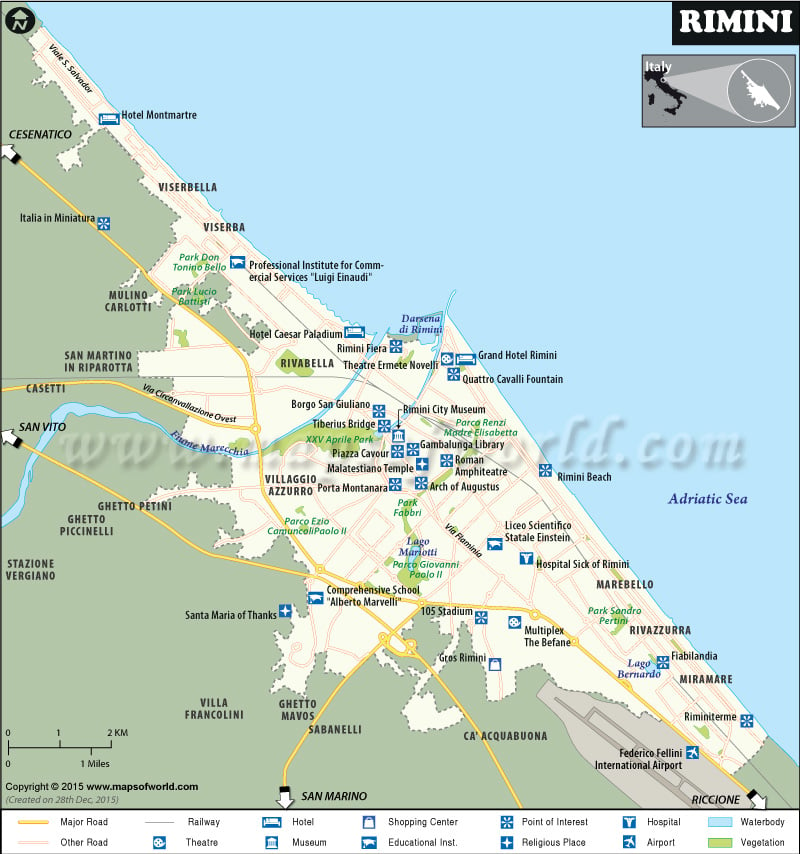It is probably the most famous seaside resort on the Adriatic Riviera, among natives. Coast navigation and fishing are the usual occupations, in Rimini, Italy. It has a total population of 136,777 in an area of 134,20 km².
Rising into prominence under the Roman Empire, Rimini, Italy(which was originally Greek in character) preserved its strategic importance with the coming of the Lombards and the final winner of the Municipality Feud, the Malatesta family. The Family lost its hold in 1528 and it came under Papal rule which was undermined by the struggles of the 18th century. In the early 19th century there was a period of comparative peace and prosperity, which was torn to shreds by the heavy bombardments of World War II. After that the city underwent a huge restoration and renovation phase to become the tourist attraction, it is today.
Location – It is located on the Adriatic coast with the coordinates of 44°03’N, 12°34’E
Reaching there – Rimini, Italy can be easily reached by the six railway stations (Rimini, Rimini Fiera, Rimini Miramare, Rimini Rivazzurra, Rimini Viserba, and Rimini Torre Pedrera ). It is also served by the airports of Rimini and San Marino and of course by the Federico Fellini International Airport.
Sightseeing – The main sights in Rimini, Italy are ecclesiastical or historical in nature, they are:
- The 13th-century Cathedral (San Francesco, best known as Tempio Malatestiano) was built in Gothic style, it was transformed by order of Sigismondo Pandolfo Malatesta and designed by Leon Battista Alberti
- The Arch of Augustus. Built-in 27 BC, has a single gate 9.92 high and 8.45 wide. The merlons were added in the Middle Ages.
- The church of San Giuliano Martire (1553-1575)
- The Tiberius Bridge – the bridge over the Marecchia River, then known as Arminius, began under Emperor Augustus in 14 and was completed under Tiberius in 21.
- The amphitheater (2nd century). was built along the old coastline, and had two orders of porticoes with 60 arcades and is elliptical in shape, the edifice could house up to 15,000 spectators.
- The Castel Sismondo or Rocca Malatestiana of Sigismondo Pandolfo was later used as a prison.
- Palazzo dell’Arengo e del Podestà (1204), seat of the judiciary and civil administrations.
- The church of St. John the Evangelist (also known as St. Augustine)
- The church of San Giovanni Battista was erected in the 12th century. It has a single nave with rich stucco decoration from the 18th century.
- The town hall has a small but valuable gallery of important artists and valuable manuscripts.
- Church of San Fortunato (1418).
- The bell tower of the former Cathedral of Santa Colomba.
- Archeological museum.
- Bronze statue of Paul V.
Accommodations – Rimini, Italy provides numerous options to a traveler in search of a place to stay. Whether it is a budget place offering only the basic amenities with food and lodging or a luxury accommodation providing all the comforts of modern technology and olde worlde hospitality – Rimini makes allowances for all.
Other features – Known as the “Ibiza of the Adriatic” Rimini, Italy provides a fascinating throbbing nightlife. Although it has no clubs of its own, its pub dance floors are always packed to capacity.
Rimini, Italy is a small but thriving community of coastal beauty, certainly worth a visit by a lover of things Italian. It may be noted in passing that Rimini counts the celebrated film director Federico Fellini among its many illustrious sons.
